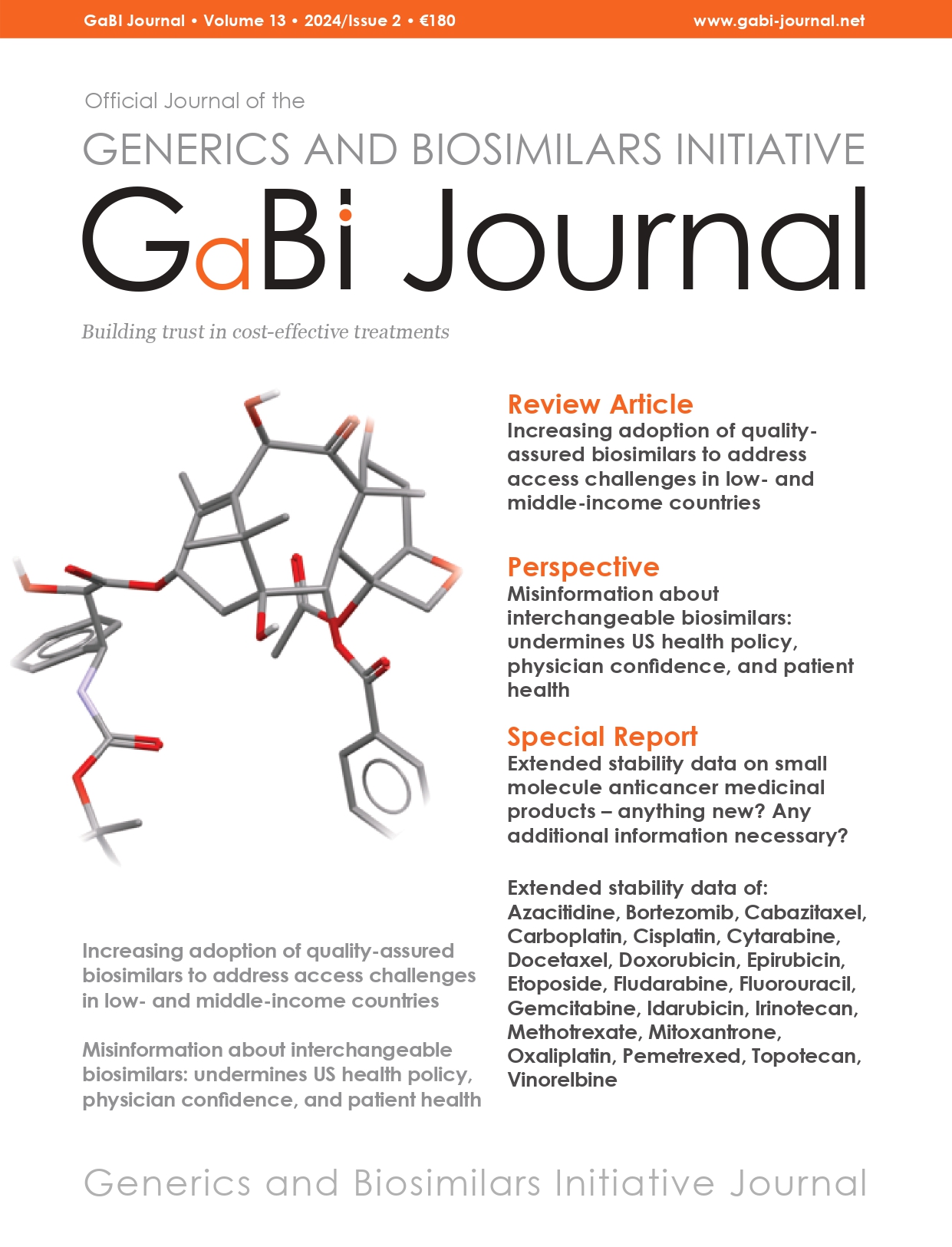How does generic drug policy affect market prices?
Published on 2018/12/03
Generics and Biosimilars Initiative Journal (GaBI Journal). 2018;7(3):136.
Submitted: 21 November 2018; Revised: 22 November 2018; Accepted: 28 November 2018; Published online first: 4 December 2018
A study published by the World Health Organization (WHO) compares the effect of different pricing policies for generic medicines in four countries [1]. Using atorvastatin as a case study, their results show that price cuts combined with price-disclosure policies lead to lasting price reductions, while price cuts alone are less effective over the long term.
There are a range of policies available to facilitate the use of generic drugs, such as mandatory generics substitution, where pharmacists must, where possible, substitute a generic drug product for a branded one; reference pricing, where the price of a generic drug is set based on similar medicines; and percentage price reductions, where the price of the generic drug is reduced by a set amount over time. However, little is known about how these policies actually influence the price of generic drugs over time.
This study investigated this issue in the context of atorvastatin, a cholesterol lowering drug marketed by Pfizer as ‘Lipitor’ and the world’s best-selling medication between 1996 and 2012.
Using Australia, New Zealand, the Republic of Korea (South Korea) and Singapore as case studies, the researched evaluated the annual price of atorvastatin, per defined daily dose (DDD, the assumed average maintenance dose per day) supplied, across each country.
They assessed data between 2006 (two years before the generic drug was introduced in all countries) and 2015 (four years after the generic drug was introduced).
Each country uses a slightly different pricing policy. In New Zealand for example, the government applies a tendering system, whereby the market is typically limited to one brand, alongside the use of preferred medicines, which means a subsidy is offered for just one or two medicines within a class.
Before generic atorvastatin reached the market, New Zealand had the lowest price for the drug (just US$0.10/DDD), while the Republic of Korea had a price almost 30 times that (US$2.89/DDD).
The Republic of Korea mandates a 30% reduction in the price of an originator drug the year after patent expiry. The first generic drug product to enter the market is priced 15% below the originator, with a further 10% reduction in both the originator and generic medicine one year after generics entry.
As expected, prices fell in all countries when generic atorvastatin was introduced – except in New Zealand, where prices were already remarkably low. The biggest drop in price after generic entry was in Singapore, where prices decreased by almost 50% in the first year after the generic entered the market. Singapore operates free pricing for manufacturers in the private market, while there is competitive tendering in the public sector. Although there is no mandatory generic substitution in Singapore, public sector institutions are encouraged to use generic drugs.
Four years after generic atorvastatin was introduced, the price had fallen in all countries, however, there were still significant price differences between countries. Prices in New Zealand remained the lowest (US$0.03/DDD) and highest in Korea (US$1.43/DDD). In the middle of the range were Australia (US$0.14/DDD) and Singapore (US$0.47/DDD).
The authors relate these price differences to policy. They suggest that the competitive tendering system utilized by New Zealand is most effective at reducing prices and led to low prices for atorvastatin even before Pfizer’s patent had expired.
However, because prices were already low in New Zealand, they did not decrease after generic versions entered the market.
Pricing policies in Australia, Korea and Singapore were more impactful after the generic entered the market and prices reduced in all countries within four years of generics entry. Prices for atorvastatin decreased by as much as 80% in Australia and Singapore, compared to just 46% in Korea.
Singapore, like New Zealand, employs a tendering system, while Australia applies mandatory price cuts on generic entry combined with price-disclosure policies. Korea meanwhile employs mandatory price cuts alone. This led to immediate price reductions for atorvastatin (25% in the first year) but the impact of this policy was not enduring, and was associated with the smallest price reduction after four years. Overall then, this study suggests that a mix of strategies for pricing generic medicines are most effective and can maximise value for money.
Competing interests: None.
Provenance and peer review: Article abstracted based on published scientific or research papers recommended by members of the Editorial Board; internally peer reviewed.
Eleanor Bird, MSc, GaBI Journal Editor
Reference
1. Roughead EE, Kim DS, Ong B, Kemp-Casey A. Pricing policies for generic medicines in Australia, New Zealand, the Republic of Korea and Singapore: patent expiry and influence on atorvastatin price. WHO South East Asia J Public Health. 2018;7(2):99-106.
Disclosure of Conflict of Interest Statement is available upon request.
Copyright © 2018 Pro Pharma Communications International
Permission granted to reproduce for personal and non-commercial use only. All other reproduction, copy or reprinting of all or part of any ‘Content’ found on this website is strictly prohibited without the prior consent of the publisher. Contact the publisher to obtain permission before redistributing.



I will gladly like to partake to this article and share some ideas as a pharmacist. Generic drugs. So far According to the latest report by IMARC Group, titled “Generic Drugs Market: Global Industry Trends, Share, Size, Growth, Opportunity and Forecast 2020-2025,” the global generic drug market size reached US$ 367 Billion in 2019, registering a CAGR of 5.7% during 2014-2019.
Thanks
Colleen
Dear Colleen,
We very much appreciate your kind feedback.
Thank you for your interest in GaBI. Please enjoy the quality information and content published under GaBI (GaBI Online and GaBI Journal).
GaBI Journal Editorial Office